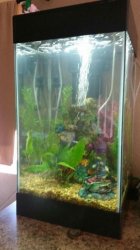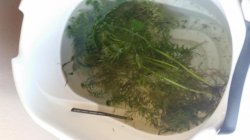I've got a cycled tank (had it about 6 months now, finished cycling last November), 15 gallons, currently 6 guppies, 2 African dwarf frogs, and a few little snails. Also has a handful of live plants in addition to plastic plants and fake coral. It's sitting near a kitchen window and a month or so ago I noticed patches of algae forming on the walls. Got a scraper and cleaned them off whenever they showed up. About two weeks ago I realized that several of the live plants in the back of the tank (near the window) were covered in sheets of algae. Not sure how I didn't notice sooner because it looked terrible. Went in, trimmed out the worst bits, and cleaned what I could. I ordered some API algaefix but after some time searching different forums found nothing but horror stories about dead fish and snails so I ended up not using it.
When I cleaned the tank I did a water change and when I was done noticed the water appeared a bit cloudy...white, like someone had poured milk in the tank. We were leaving on vacation the next day, so I really didn't have time to worry too much about it...figured it would settle out. I did close the kitchen curtain to try to curtail the algae regrowth a bit.
Had a pet sitter watching my cat while we were gone and told her just to feed the fish a pinch of flakes each morning and otherwise not mess with the tank. I came home to disaster. The algae had not only regrown (no surprise) but the water was much cloudier (still white) and I found a (long) dead fish and a dead snail. The tank looked filthy. I tested the water (API master test kit) and found elevated ammonia and the nitrates were quite high. Cleaned out the dead friends and did an emergency water change and changed the carbon in the filter.
After that the water tested better but continued to look bad. Several live plants were totally coated in algae and the white cloudiness remained. I was still scared to use the algaefix but didn't know how else to get the algae off the live plants. I ended up pulling them out of the tank and putting them in a 5 gallon bucket of water, then treating the bucket with the algaefix. Figured if I lost plants, I lost plants, but at least the fish would be protected from that.
I siphoned the gravel and did a water change to try to eliminate any sources of food for the excess bacteria and got an embarrassing amount of stuff up. Repeated the next day. Water was still testing fine at this point.
I've been testing the water daily and have siphoned several more times to try to really get the substrate clean. I'm changing the carbon in the filter every couple of days and I added another submersible filter because I read some reviews that the filter that came with my tank is a bit underpowered.
The plants are looking much better in the bucket and I actually added the first one back to the tank today. The water is still cloudy though! I'm out of ideas. Do I just need to be patient and keep the tank clean and it will fade, or should it be gone by now? Anything anyone can suggest to eliminate this bacteria that I haven't tried? I prefer not to use chemicals to treat it...would rather find the imbalance. I've reduced feedings because I think we were definitely overfeeding, and I think doing that massive algae cleanout before we went on vacation overwhelmed the filter and set me up for the rest of the problems.
Appreciate any input. I feel like the algae will be an ongoing thing, but would really like to get the white cloudiness out of the tank.
Currently:
ph 7.8
ammonia 0
nitrite 0
nitrate minimal...just a slight tint to the test bottle
phosphate also minimal...hard to say if it's 0 the color blocks are so similar
When I cleaned the tank I did a water change and when I was done noticed the water appeared a bit cloudy...white, like someone had poured milk in the tank. We were leaving on vacation the next day, so I really didn't have time to worry too much about it...figured it would settle out. I did close the kitchen curtain to try to curtail the algae regrowth a bit.
Had a pet sitter watching my cat while we were gone and told her just to feed the fish a pinch of flakes each morning and otherwise not mess with the tank. I came home to disaster. The algae had not only regrown (no surprise) but the water was much cloudier (still white) and I found a (long) dead fish and a dead snail. The tank looked filthy. I tested the water (API master test kit) and found elevated ammonia and the nitrates were quite high. Cleaned out the dead friends and did an emergency water change and changed the carbon in the filter.
After that the water tested better but continued to look bad. Several live plants were totally coated in algae and the white cloudiness remained. I was still scared to use the algaefix but didn't know how else to get the algae off the live plants. I ended up pulling them out of the tank and putting them in a 5 gallon bucket of water, then treating the bucket with the algaefix. Figured if I lost plants, I lost plants, but at least the fish would be protected from that.
I siphoned the gravel and did a water change to try to eliminate any sources of food for the excess bacteria and got an embarrassing amount of stuff up. Repeated the next day. Water was still testing fine at this point.
I've been testing the water daily and have siphoned several more times to try to really get the substrate clean. I'm changing the carbon in the filter every couple of days and I added another submersible filter because I read some reviews that the filter that came with my tank is a bit underpowered.
The plants are looking much better in the bucket and I actually added the first one back to the tank today. The water is still cloudy though! I'm out of ideas. Do I just need to be patient and keep the tank clean and it will fade, or should it be gone by now? Anything anyone can suggest to eliminate this bacteria that I haven't tried? I prefer not to use chemicals to treat it...would rather find the imbalance. I've reduced feedings because I think we were definitely overfeeding, and I think doing that massive algae cleanout before we went on vacation overwhelmed the filter and set me up for the rest of the problems.
Appreciate any input. I feel like the algae will be an ongoing thing, but would really like to get the white cloudiness out of the tank.
Currently:
ph 7.8
ammonia 0
nitrite 0
nitrate minimal...just a slight tint to the test bottle
phosphate also minimal...hard to say if it's 0 the color blocks are so similar

 /www.fishforums.net/index.php?/topic/440854-api-readings/
/www.fishforums.net/index.php?/topic/440854-api-readings/

